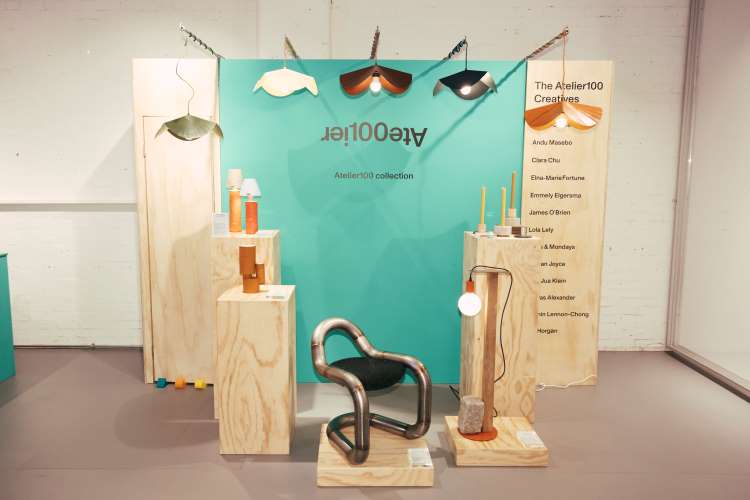Atelier100 launches collection of “hyper-local” products from London creatives

by IBRAHIM
Atelier100 launches collection of “hyper-local” products from London creatives
Ingka Group and H&M’s retail project showcases what can be done when designers use short city-wide supply chains and manufacture within the capital.
Six months after the “hyper local” Atelier100 project was launched, the work of thirteen London-based creatives has gone on sale in Atelier100’s Hammersmith store.
This follows Ingka Group (the largest Ikea franchisee) and H&M inviting creatives to apply to a programme supporting the design and manufacture of goods created within 100km (62 miles) of London.
According to Atelier100, the design project looks to a “future of making that is rooted in local supply, manufacturing and distribution”, aiming not only to reduce carbon impact but also to “build local supply chains, strengthen local production networks and support local economies”.

Reflecting on the rapidity of the project, H&M global brand innovation manager Camilla Henriksson says “for our big companies […] it’s very quick”, adding that they were “extremely proud” to see the products now on sale.
The creatives were provided with mentorship and workshops throughout the programme “to help them with brand, business and marketing support”, Atelier 100 says.
Introducing the mentorship aspect of the programme, Markus Engman, chief creative office at Ingka Group says “it’s about being open. If you’re a big company like Ikea and H&M you sit on a lot of traditions that hinder you from change, but you also sit on a lot of expertise”.
He adds, “[Ikea] is turning 80 next year. That’s quite a long time for a company to be around and I think our responsibility is to make things better […] the best way to do that is to be open and to share your knowledge”.
Engman also adds that both the designers and the companies have learned a lot from the hyper-local concept, saying “you get ideas from being close to production when you are a designer”.
Stainless Steel Tubular Chair by Andu Masebo
Product designer Andu Masebo has created a tubular stainless-steel chair with a recycled chip rubber seat. The tubes have been shaped using mandrel bending, a method by which a steel rod inserted in the tube while it is bent prevents the crushing of its internal space. It is a technique also used by car exhaust manufacturers and by using these manufacturers’ specific knowledge it “allows the scope for the chair to be affordable” Masebo says, “but it also creates limitations as to how the chair can be designed”.
He chose to make a feature of the typically concealed “tig weld”, leaving evidence of the process like “metaphoric thumbprints”. He suggests that a connection to the making process can help consumers think more carefully about the conditions in which their furniture is made.
Thames Clay Vase by Alison Cooke
Ceramicist Alison Cooke explains that “it’s the location that interests me” with material. She typically works with clays from construction sites of particular geological or historical interest; for this project, she sourced clay from 26 metres below the River Thames, dug up by Tideway in the process of constructing the London super sewer. “This clay was laid down 54 million years ago and it’s quite tricky to work with… to put it mildly”, Cooke says.
The vases’ form is inspired by the network of boreholes running under London, created when building the tunnels that “keep us all connected and keep the city running”, she says.
London Paper Mache Table Lamp by Emmely Elgersma
Sculptor, ceramicist and football coach Emmely Elgersma has created a collection of brightly coloured paper mache-covered table lamps for Atelier100. For the base, Elgersma used tennis ball tubes discarded by tennis clubs across London, topped with reclaimed lampshades.
Elgersma has previously worked with paper mache, including creating structures for the Guinness World Book of Records. The paper here comes from copies of the Evening Standard discarded on the Underground, then mashed up to coat the lamps, before being painted by hand.
Sculptural Door Stop by Yasmin Lennon Chong
Designer Yasmin Lennon Chong’s sculptural doorstops are an example of her interest in “unpopular design typologies”, she says, “the things that exist in our everyday environments that are often overlooked”.
The doorstops are 3d-printed using recyclable flexible thermoplastic polyurethane (TPU), as she is interested in exploring it as a method of “sustainable print-on-demand production”, working with “small-batch limited edition products” and “fully circular materials”.
Their specific forms are inspired by architectural elements found around the city, but they are mostly “intended as just very playful interior products”, she says.
Alphapets: Laser Cut Animal Card Set by Nathan Joyce
Illustrator and stock-motion animator Nathan Joyce has created a colourful card set for Atelier100. Made from double side printed uncoated card, the Alphapets are “essentially model animals made from letters”, he says. “The word beetle can slot together to make the word beetle; the word crocodile becomes a crocodile and so on and so forth”.
Aimed at both children and adults, “they are designed to encourage a bit of creative thinking and give a reason to take the models apart again once they’ve been made”, rather than assembling it once and “putting it on the shelf and forgetting about it”, he says. “You can also slot them together to make weird monsters”, he adds.
All thirteen designers’ work is available to purchase in-store at Atelier100, Livat Hammersmith mall, London and more information is available on its website.
Banner image shows the thirteen creatives at the launch of the Atelier100 collection. Photo by Luke Fullalove.
Recommended Posts

NB invites local designers centre stage for Vineyard Theatre rebrand
February 24, 2023

“AI revolution” will change way design studios look within three years
February 24, 2023

Rbl rebrands ZSL with ecosystem-inspired identity
February 23, 2023

